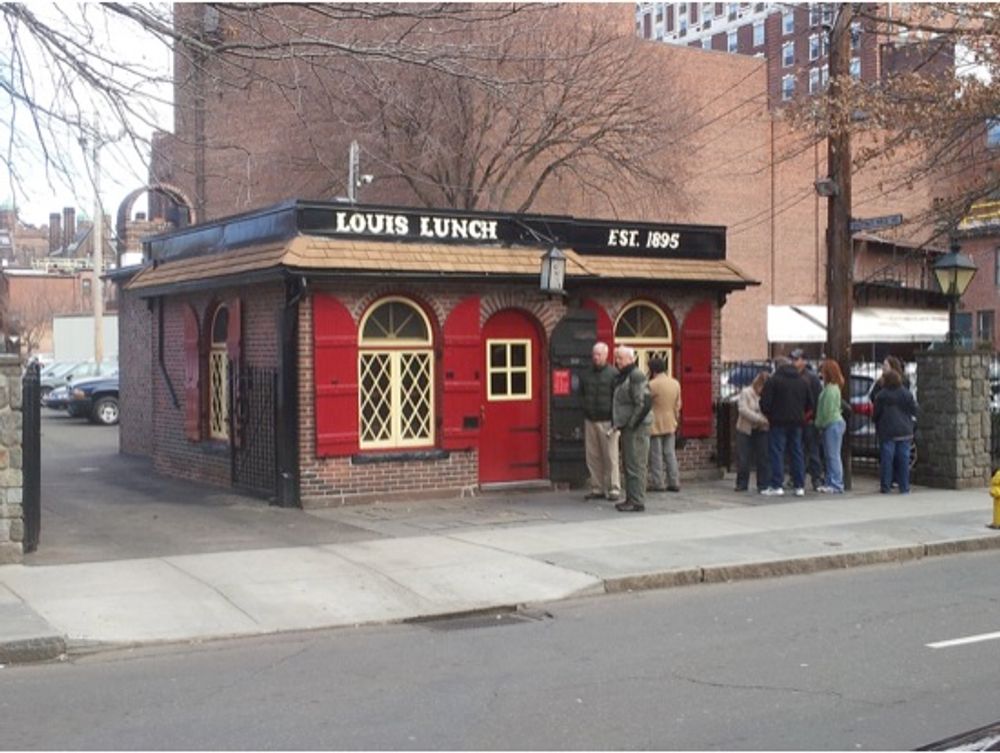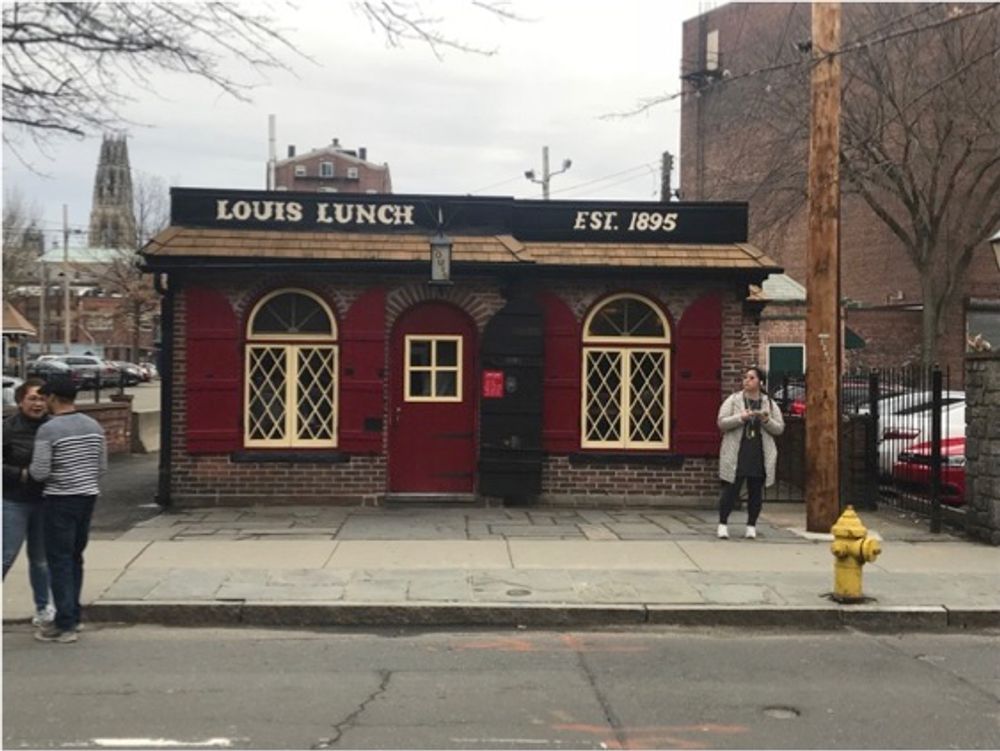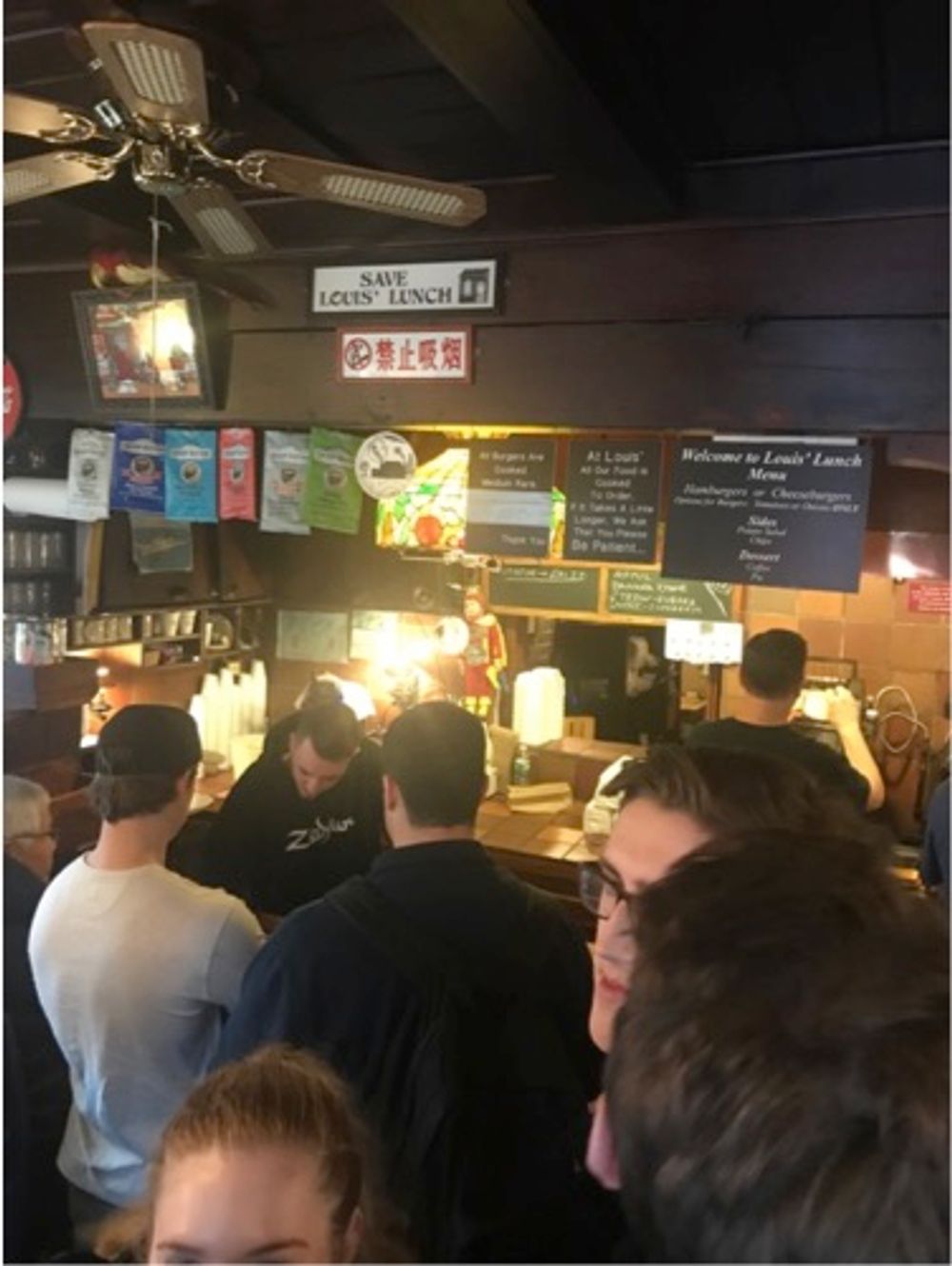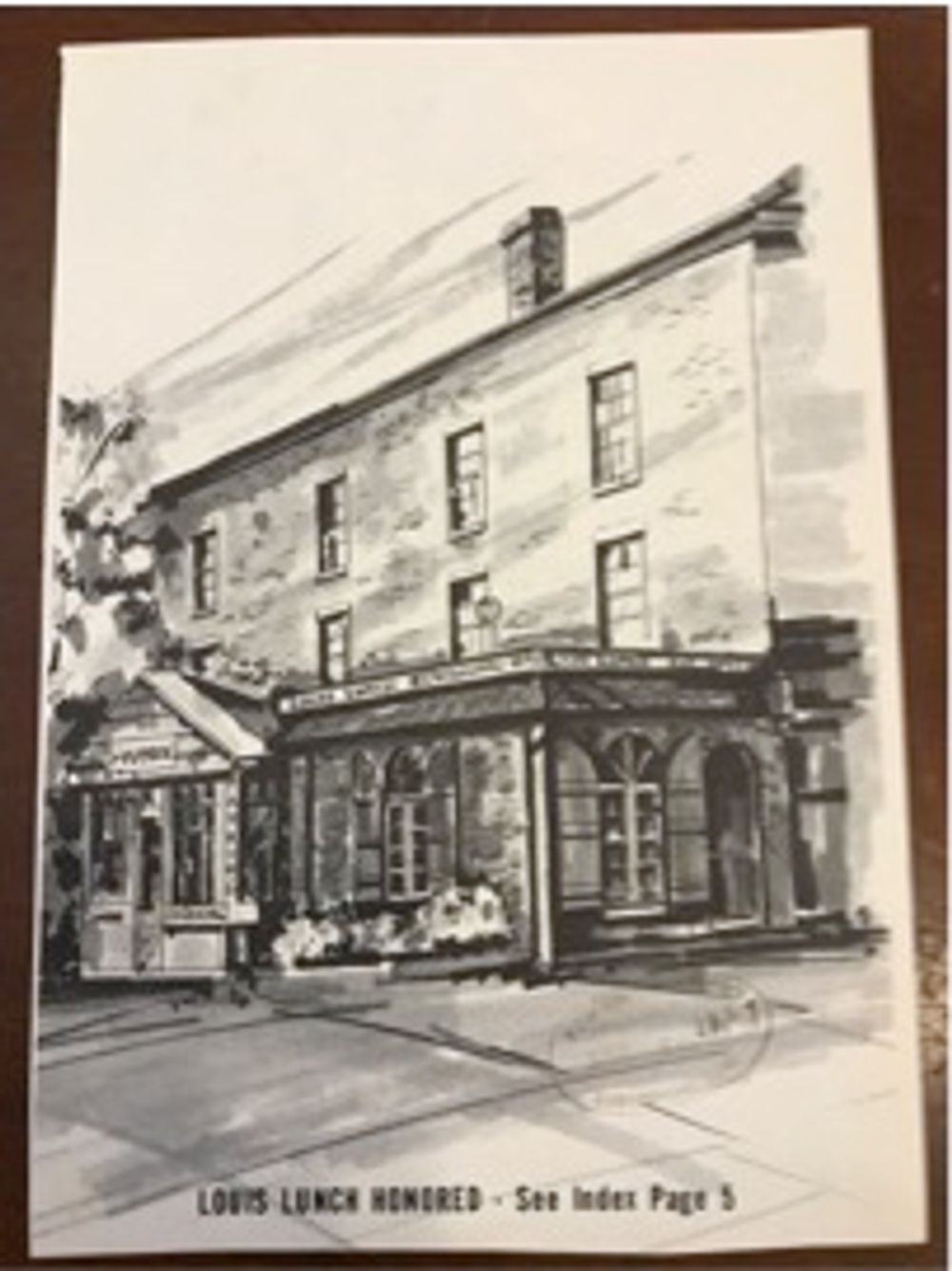
Louis' Lunch
261-263 Crown Street
It is not uncommon to see a long line of customers spilling out of the entrance to Louis’ Lunch on Crown Street. The restaurant, which has been credited with the invention of the hamburger, currently occupies a small red brick Tudor-style building in downtown New Haven. With parking lots on either side of and behind the building, Louis’ Lunch proudly stands on its own. The front door is made of wood painted a deep red color, and latticed windows complimented by red wooden shutters on either side of the door allow curious passerby to peek in on the action inside. The building is hard to miss, with “Louis’ Lunch” and “Est. 1895” painted in white capital letters on the side of the building facing the street. Those who choose to venture inside will find that the burgers are served on toast instead of buns and common condiments like ketchup and mustard are forbidden. A visit to Louis’ is like taking a trip back in time, giving all those who stop by a chance to take a bite of New Haven history.
- 261 Crown Street: Mrs. Rachel Thill (pre-1913/1913 until sometime before 1973)
- 263 Crown Street: Berry L. Mott (pre-1913/1913 until sometime before 1973)
The exact length of both residents’ tenancy at 261-263 Crown Street is unknown, but their names were listed as living at those addresses in the New Haven 1913 Directory (1). By 1973, they no longer occupied the lot as the building there had been demolished and the lot was left empty (2).
In 1886, the lot at 261-263 Crown Street was occupied by a brick dwelling that appears to have been split into two separate (but attached) homes (27). According to the New Haven 1913 Directory, both sides of the dwelling were occupied for some time, with Mrs. Rachel Thill living at 261 Crown Street and Mr. Berry L. Mott living at the 263 address (28). The length of their tenancy is unknown, but the 1973 New Haven Sanborn map reveals the dwelling to be gone by that point, leaving the lot empty (29). On June 27, 1975 Kenneth Lassen revealed that the lot of 261-283 Crown Street had been purchased and that it would be the new home of Louis’ Lunch (30). The original building was moved to the new site in July of 1975 and has remained there ever since (31). An addition for the structure was built in 1975, expanding the building to its current dimensions of approximately 26’ x 36’ (32).
In 1895 Louis Lassen, a New Haven resident, opened a lunch wagon and stationed himself on Meadow Street in downtown New Haven, and thus Louis’ Lunch was born (12). A short five years later, history was made when Louis himself created and served the first hamburger from that very same wagon (13). After moving to George Street in 1907, and spending more than 10 years working out of his wagon there, Louis finally found a more permanent home for his restaurant in 1917, a little brick building at the corner of Temple and George Streets (14). The main portion of the building that Louis’ Lunch now occupies was built in the mid 19th century as a part of an industrial complex and up until 1917 the structure served as an office space for the neighboring George Street tannery (15).
For nearly fifty years the Lassen family served hamburgers from that location, and Louis’ Lunch quickly became a beloved lunch spot for New Haveners and tourists alike (16). Official recognition of the restaurant’s significance came in September of 1967, when the New Haven Preservation Trust made Louis’ Lunch an official monument (17). However, trouble still came for Louis’ in the mid 20th century during the mayorship of Richard C. Lee when a wave of urban renewal initiatives were implemented with the intent to transform New Haven into a “Model City” (18). A major side effect of this renewal was the demolition of over 2,000 buildings in order to create spaces for redevelopment (19). What is more, in March of 1974, the New Haven Redevelopment Agency approved plans to build the multi-million dollar Temple Street Medical Center where Louis’ stood (20). This decision was met with public outcry, and so the fight to save Louis’ began (21). Just three months later, the public’s pleas were met with the Agency’s promise to pay $8,500 to move the building that Louis’ Lunch occupied to another location (22). In June 1975, Louis’ Lunch closed, and in July the entire building was put on a truck and driven the two blocks to its current location on Crown Street (23).
Not only was the building preserved during this transition, so were the traditions within it. Today, burgers at Louis’ are served the same way they were over a century ago, on white Pepperidge Farm toast sliced diagonally (24). Ketchup and mustard are nowhere to be found, and a sign inside sums up Louis’ approach to burgers pretty well: “This is not Burger King, you don’t get it your way. You take it my way, or you don’t get the damn thing.” The building remains the only example of pre-1900 architecture to have survived urban renewal efforts in downtown New Haven and thus serves to keep an important part of the city’s history alive that has otherwise disappeared (25). The bricks of so many buildings that were demolished live on in the walls of Louis’, alongside bricks donated by people and places all over the world (26). Louis’ Lunch may be small in square footage, but the immense significance that it holds not only as the home of the original hamburger, but also as a time capsule of New Haven history and the world, is what truly renders Louis’ Lunch a monument.
Louis’ Lunch is situated on Crown Street, which hosts a blend of commercial and residential buildings and lots (11). Unlike the other buildings on the street, which stand in close proximity to one another, Louis’ stands alone and the building is surrounded by parking lots on three sides. It is also interesting to note that Louis’ sits further back from the sidewalk than the other buildings on the street, adding a fourth dimension to the physical separation that the building has from neighboring structures. Louis’ eye-catching brick and wood entrance causes the building to stand out as its own vibrant entity amidst what appears to be an otherwise fairly neutral urban landscape.
This 1 story-establishment is composed of brick and features handcrafted woodwork including a red door and red shutters framing the windows (3). The wooden elements are evocative of half-timbering characteristic of Tudor-style architecture, and the brick archways that frame the door and windows are suggestive of the same style as well (4). Two casement-like round-top windows. one on either side of the door, have cream colored diamond-shaped lattice designs that contrast with the red hue of the bricks and shutters (5). The building has a flat roof as well as a brown-shingled shed roof attached to three sides of the building about a foot below the flat rooftop (6). When the building was moved from its original location at George and Temple Streets in 1975, a $35,500 addition was made to expand the building on the Crown Street site, increasing the building’s capacity from 14 persons to approximately 24 persons (7). The bricks used to build the walls of the addition were sourced from the floor of the old George Street tannery (this building had served as office space for the tannery before it was occupied by Louis’ Lunch) as well as demolished buildings in New Haven (8). Kenneth Lassen, the building’s owner at the time of the addition, also collected bricks from friends, family, and even strangers all over the world that were used in the expansion of the original structure (9). The cozy interior of the building features an open kitchen with a service bar, exposed brick on the walls, as well as robust wooden furniture and a wood-paneled ceiling (10).
- New Haven Directory (New Haven: Price & Lee Co., 1913), 895.
- Sanborn Map Co., Insurance Maps of New Haven Connecticut, Vol. 1, 1973, 3.
- New Haven Historic Resources Inventory (New Haven: The New Haven Preservation Trust).
- New Haven Historic Resources Inventory; Encyclopaedia Britannica, s.v. “Tudor Style,” accessed February 24, 2018, https://www.britannica.com/art/Tudor-style.
- New Haven Historic Resources Inventory.
- Ibid.
- Stanley J. Venoit, “Louis’ Lunch Readies for Reopening,” New Haven Register, November 12, 1975.
- Ibid.
- Ibid.
- New Haven Historic Resources Inventory.
- Ibid.
- Owen Rogers, “Louis’ Lunch and the Birthplace of the Hamburger,” ConnecticutHistory.org, https://connecticuthistory.org/louis-lunch-and-the-birth-of-the-hamburger/.
- Ibid.
- Ibid.
- New Haven Colony Historical Society, “Agency to Save Louis’ Building,” June 14, 1974; Venoit, “Louis’ Lunch Readies.”
- Rogers, “Louis’ Lunch and the Birthplace.”
- New Haven INFO, “Louis Lunch: New Haven’s Mini Restaurant Adds to It’s Laurels,” November, 1967.
- Rogers, “Louis’ Lunch and the Birthplace”; ConnecticutHistory.org, “Richard Lee’s Urban Renewal in New Haven,” https://connecticuthistory.org/richard-lees-urban-renewal-in-new-haven/
- Ibid.
- Andrew L. Houlding, “Louis’ Loses to Center,” New Haven Journal- Courier, March 22, 1974.
- David L. Perkins, “Louis’ Lunch Opens Monday,” New Haven Journal-Courier, March 19, 1976.
- Ibid.
- Ibid.
- Rogers, “Louis’ Lunch and the Birthplace.”
- Bruce Landis, “Will Louis Be Invited to Lunch?,” New Haven Journal-Courier, October 26, 1973.
- Venoit, “Louis’ Lunch Readies.”
- Sanborn Map Co., Insurance Maps of New Haven Connecticut, Vol. 2, 1886, 4.
- New Haven Directory, 895.
- Sanborn Map Co., 1973, 3.
- Perkins, “Louis’ Lunch Opens Monday.”
- Perkins, “Louis’ Lunch Opens Monday.”
- Venoit, “Louis’ Lunch Readies."
Researcher
Chase Leisenring
Date Researched
Entry Created
February 25, 2018 at 10:23 PM EST
Last Updated
February 26, 2018 at 10:45 PM EST by null
Historic Name
Style
OtherCurrent Use
CommercialRestaurantEra
1638-18601860-1910Neighborhood
OtherOtherTours
Year Built
circa 1850
Architect
Current Tenant
Louis' Lunch
Roof Types
FlatShedStructural Conditions
Very Good
Street Visibilities
Yes
Threats
None knownExternal Conditions
Very Good
Dimensions
approximately 26’ x 36’ with floor area of 704 sq ft
Street Visibilities
Yes
Owner
Jeffrey W. Lassen 1988 Trust
Ownernishp Type
Client
Historic Uses
ManufacturingIndustrial










Comments
You are not logged in! Please log in to comment.